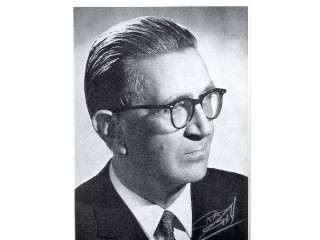
Leonard Bloomfield biography
Date of birth : 1887-04-01
Date of death : 1949-04-18
Birthplace : Chicago, Illinois, United States
Nationality : American
Category : Famous Figures
Last modified : 2011-10-13
Credited as : linguist, ,
The influence of the American linguist Leonard Bloomfield dominated the science of linguistics from 1933—when his most important work, Language, was published—to the mid-1950s.
Leonard Bloomfield was born on April 1, 1887, in Chicago. He graduated from Harvard College at the age of 19 and did graduate work for 2 years at the University of Wisconsin, where he also taught German. His interest in linguistics was aroused by Eduard Prokosch, a philologist in the German department. Bloomfield received his doctorate from the University of Chicago in 1909.
After teaching German at the University of Cincinnati for a year, Bloomfield became assistant professor of comparative philology and German at the University of Illinois, where he remained until 1921. His An Introduction to the Study of Language was published in 1914.
In 1913-1914 Bloomfield studied in Leipzig and Gottingen, Germany, with the neogrammarian scholars August Leskien and Karl Brugmann. Neogrammarian historical philology emphasized the regularity of sound change in language without exceptions, any apparent exceptions being explained in terms of nonphonetic phenomena. This view represented a scientific advance over the earlier view that extraordinary, inexplicable sound change can take place. Bloomfield emphasized throughout his career the scientific neogrammarian methodology of seeking out regularity in sound change rather than appealing to random, meaningless change. This approach brought much order to historical linguistics.
Bloomfield adopted Ferdinand de Saussure's concept of language structure. Saussure emphasized that languages at any one time were systems of interrelated elements: lexical, grammatic, phonological. Bloomfield accepted Saussure's distinction between a diachronous (time being a variable) approach and a synchronous (time being a constant) approach to language. He utilized both approaches in his work. He envisaged diachronous language change in the course of the history of a language as a succession of language structures, each viewed synchronously.
Franz Boas was the first anthropological linguist to emphasize descriptive study of non-Indo-European languages as they exist today. Bloomfield, who acknowledged his debt to Boas, emphasized the value of synchronic descriptive linguistics, though he never deserted diachronic historical linguistics. Though trained in historical Indo-European, especially Germanic, philology, Bloomfield turned to a study of Tagalog, a Malayo-Polynesian language, during World War I. In 1917 he became interested in a more accessible language family, the Algonquian. His linguistic work with Indians of the Algonquian family in Wisconsin was not only descriptive; he also applied historical linguistic techniques to this language family. He showed that the neogrammarian methodology of assuming regularity in sound change was applicable beyond the Indo-European language family.
In 1921 Bloomfield became professor of German and linguistics at Ohio State University. There he met the behaviorist psychologist A. P. Weiss. Both men took a logical positivist approach to science; they agreed that a mechanistic rather than a mentalistic approach to human phenomena was necessary if the disciplines concerned with man were to be truly scientific.
Bloomfield was one of the founders of the Linguistic Society of America in 1924. He was professor of Germanic philology at the University of Chicago from 1927 to 1940, when he became professor of linguistics at Yale University. He died in New Haven, Conn., on April 18, 1949.
In Language Bloomfield emphasized the need to be objective, to deal only with physically observable phenomena, and to develop a precise description and definition in order to make linguistics a true science. The period from the publication of Language in 1933 to the mid-1950s is commonly called the "Bloomfieldian era" of linguistics. Though Bloomfield's particular methodology of descriptive linguistics was not widely accepted, his mechanistic attitudes toward a precise science of linguistics, dealing only with observable phenomena, were most influential. His influence waned after the 1950s, when adherence to logical positivist doctrines lessened and there was a return to more mentalistic attitudes. Today linguists, especially the younger ones, are more concerned with the directly nonobservable mental processes by which human beings are uniquely capable of generating language.
















